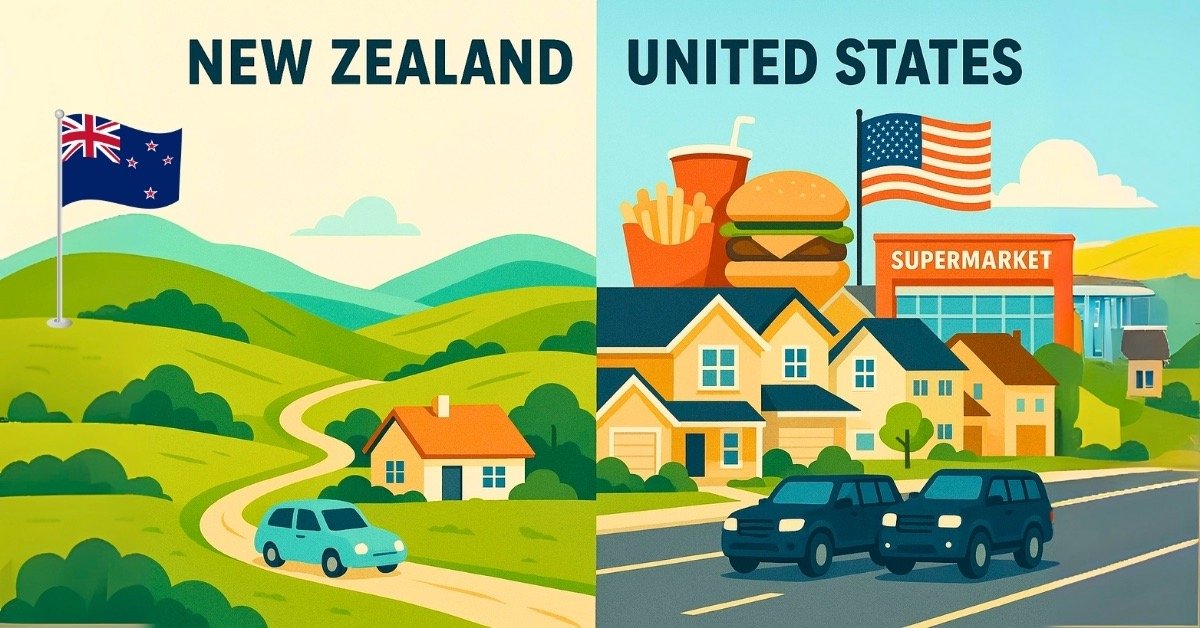Moving from NZ to the US? These American Lifestyles May Surprise You
Relocating from New Zealand to the United States involves more than just changing time zones— American Lifestyles often means adapting to a very different way of life. Despite sharing a language and some Western cultural values, there are notable contrasts in everyday norms, systems, and expectations.
Size and Scale
The size of things in the US is often one of the first shocks. Homes, vehicles, meals, and even shopping trolleys are all noticeably larger. Yet, according to World Population Review (2024), the average single-family home in the US is about 201 square metres (2,164 sq ft), slightly smaller than New Zealand’s 202 square metres (2,174 sq ft). Other 2025 sources place the US average slightly higher, around 204 m².
More than size, it’s the layout that surprises many: garages, open-plan spaces, walk-in wardrobes, and finished basements are common. Restaurants and supermarkets follow the same trend—larger spaces, more options, and bigger portions.
Driving Is Essential
Public transport in the US is patchy, especially outside large cities. Over 85% of Americans commute by car (US Department of Transportation), and suburbs are generally built with car use in mind. Footpaths can be rare, and daily errands often require driving. By contrast, urban centres in New Zealand are improving access to trains, buses, and cycleways, but driving remains more optional than in many US locations.
Healthcare Isn’t Free—or Simple
The US healthcare system is primarily private and insurance-based. Emergency services are available, but everyday medical care, prescriptions, and hospital stays can be prohibitively expensive without cover. In contrast, New Zealand’s public system is largely tax-funded.
The Commonwealth Fund regularly ranks US healthcare as the most expensive among developed nations, often without proportionally better outcomes. Newcomers should secure adequate insurance as early as possible.
Tipping Is Expected
Tipping in the US isn’t discretionary—it’s part of the wage structure. Restaurant staff, taxi drivers, barbers, and porters often rely on tips to supplement low base pay. A 15–20% tip is standard in most service settings, and not tipping is considered rude. For New Zealanders, this cultural norm takes some adjusting.
Work and Leave Culture
Americans tend to work longer hours with less paid leave. While New Zealand guarantees four weeks of annual leave, many US workers receive only ten days, and some none at all. Parental leave is also not federally mandated, though individual states and employers may offer it.
Short lunch breaks, fewer public holidays, and a strong focus on productivity over time off can be surprising for those used to New Zealand’s more balanced approach.
Food and Ingredients
American supermarkets offer an enormous variety, but many processed foods contain high-fructose corn syrup, preservatives, or artificial colours less common in New Zealand. Fresh produce is widely available, but prices and quality vary. Fast food is deeply embedded in the culture and often more affordable than fresh groceries.
Education and Schooling
Public education quality in the US varies by district because funding is tied to local property taxes. This leads to significant differences even within the same city. For families, choosing where to live becomes a key factor in accessing good schools.
American schools also place high value on extracurriculars, sports, and events like prom and homecoming, less central to New Zealand’s education system.
Patriotism and Cultural Identity
American patriotism is visible and public. Flags, national anthems, and the Pledge of Allegiance are daily norms, particularly in schools. National holidays like the Fourth of July are widely and enthusiastically celebrated. Kiwis accustomed to a more reserved sense of national identity may find this striking.
Why These Differences Matter When You’re Making the Move
Relocating to another country isn’t just about getting from A to B—it’s about adapting to systems, habits, and expectations that may be entirely new. Everyday routines, from tipping at restaurants to arranging healthcare or choosing schools, can feel unfamiliar even when the language and culture seem broadly aligned.
Being aware of these differences before you go can make settling in far smoother. For those who are considering the US, moving to the USA from New Zealand with Crown Relocations is one option among others—but regardless of how you get there, understanding the lifestyle shift is key to navigating it well.
Final Take
Adjusting to life in the US means more than changing your address. From service expectations to school systems, daily life can feel familiar on the surface but operate very differently. Awareness is the first step to easing that transition.
Also Read: Virginia Time Zone: Everything You Need to Know








